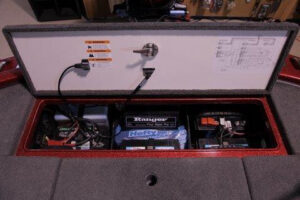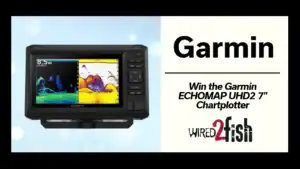When most anglers are asked “what is the most important compartment in your boat,” the answers are all over the board. Some say it’s where they put their high dollar rods. Other may say its where they keep their tackle and yet others will say its the cooler. Most answers never include the dark and gloomy back compartment where batteries, charger, oil reservoir, and pumps are housed. It should be the number one compartment, but for many anglers, it’s a place that only mechanics go. Boat dealers love that way of thinking, but in reality it is “the most important compartment in the boat.”
The rear compartment is a scary spot. Wires, breakers, batteries and chargers are not glamorous, and most of us don’t have a clue about what goes to what. The dealer hooks them up, and if something breaks or needs maintenance, heaven forbid, it’s like building the space shuttle or figuring out the wiring schematic to nuclear reactor. The day you purchase your boat, it should be priority one to know how it was set up. Twenty four volts? Thirty six volts? If a pump goes out, it’s time to get a new boat. That may sound drastic to some, but in reality most anglers don’t know beans from apple butter about that part of their boats.
There are several simple things a boater can do to assure they won’t have issues, and if there is an issue, get the knowledge to avoid panic. It’s not rocket science and most answers can be found by calling your dealer of looking it up on the Internet. Most times, it’s not scary; it’s procedural.
1. Batteries – Batteries have gotten much better in the last few years, and if properly maintained, they will last a very long time. They are built to withstand the punishment, and it’s important to keep a log of when you purchased them and what kind of batteries they are. Brand name is important too. Are they gel cell, are they lead/acid, are they maintenance free or do they require some distilled water now and again. The battery’s biggest enemy is heat. If they overheat, which is usually caused by lack or water or age, it cuts down their life expectancy, and it’s important to make sure they are properly charged and maintained. Deep cycle batteries are designed to drain and be re-charged. They have heavier/thicker plates and can take the wear and tear and vibration more effectively. They are not used for a “jump” charge but rather for long life.
Always test your batteries after they are fully charged. Check water levels in each cell of the battery to make sure its filled but not too full. For battery life and charge measurement use a three ball hydrometer or a battery powered battery tester. Both are inexpensive and will measure voltage and give you a true reading of life of that battery. Higher priced testers will test the battery under load for an even a better measurement.
Boating batteries are divided by type with Deep cycle, Commerical/Industrial, AGM, Gel Cell and sealed/low maintenance. You can usually tell a better battery by price but most boats come equipped with Deep Cycle batteries. Deep cycle batteries are moderately priced and will perform well in most fishing boats.
2. Chargers – There are numerous good chargers on the market today. Finding the best one is usually based on price and features. Automatic chargers and those with built-in intelligence seem better for anglers. Hook them up, plug them in and the charger does the rest. A charger that provides a full charge with low charge maintenance charging is a good option. Today’s chargers are much more sophisticated than the old ones.
The good ones monitor the charge and give the most charge to the least charged battery. It is very important to make sure battery connections are tight and free from deposits. A high grade light lubricant like Royal Purple’s Maxfilm or a good gun oil will do the job.There is no such thing as a quick charge. You can get the battery in a position to start the engine but the battery will have up to 25 percent less efficiency if not fully charged after a quick charge was applied.
You can build in adverse battery memory by not fully charging your batteries immediately after use, and they may not ever be as effective again. Spending more money on a great charger is better in the long haul and can actually save money over the life of the boat on batteries. Dual Pro, Pro Mariner, Guest and Minn Kota build some good intelligent chargers that do the job. Talk to several users before you purchase an on board charger. Their experiences can be invaluable and help with your purchase.
3. Bilge and livewell pumps – It is crucial to keep sump areas of your boat as clean as possible. Loose dirt, leaves or even line clippings can cause your pump to fail. We like to put a few gallons of water mixed with a good dish washing degreaser type soap like Dawn in the sump a couple times per year. Close the drain plug, add soap and water, drive around the block, turning and stopping if possible and then drain can eliminate grime that has built up. It’s also good to drain and dry the sump area a few times per year.
Livewell pumps are a different animal, and even though they work much like a bilge pump, cleaning them is a bit more complicated. Make sure all livewell screens are cleaned routinely. Small crawfish pinchers, scales or even fish waste can cause them to quit working properly. The impeller can get clogged and the pump will stress and possibly burn up. Fill livewells a few times per year with tap water to capacity adding a cap or two of hydrogen peroxide and a bit of U2 or non salt additive during this process to cleanse these pumps without harming fish on a later trip. We also will add this additive to season the livewell during this cleaning. Drain the livewell completely and oil and maintain fill/empty switches at the same time.
4. Oil reservoir – A simple check of this tank can insure caps are tight and no leaks are evident. If your boat is equipped with an external fill port, check the hose and neck of the tank and tighten clamps or screws. A leaky tank can cause other messes and problems. Always keep this tank full to the fill line even when stored.
5. Breakers and power switches – Many boats have a main breaker and power switch for the trolling motor in the back compartment. It’s good to use a damp rag with some soap on the outside of these if they are dirty. Test at this time by throwing the switch a time or two as well. If they do not work, replace them. They are not an item that can be repaired easily. If your boat is stored for a period of time during the winter, turn both switches to the “OFF” position. Check circuits fully and make sure you place extra fuses in the boat this time of year as well. Keep them in a dry compartment in a sealable plastic bag with a puller. Never replace a higher amp fuse in a lower amp socket as it can cause issues and a possible fire problem.
We always keep a set of heavy duty jumper cables in a Hefty One Zip bag in the boat. Longer cables are better. We also keep wheel chocks stored in the rear compartment, as well,












